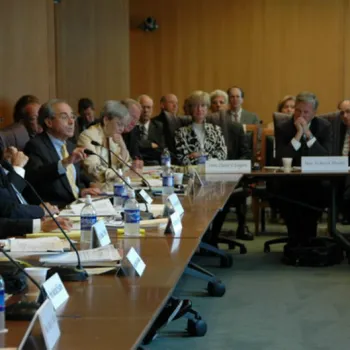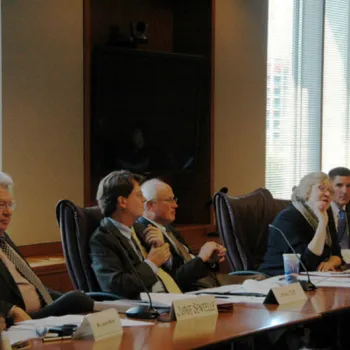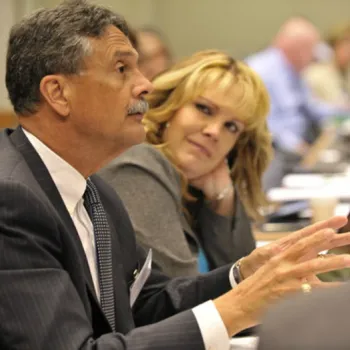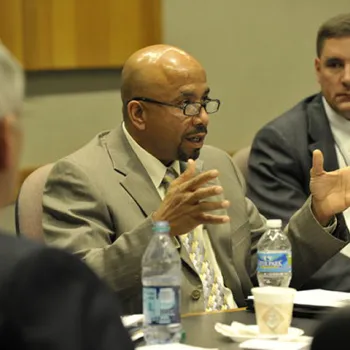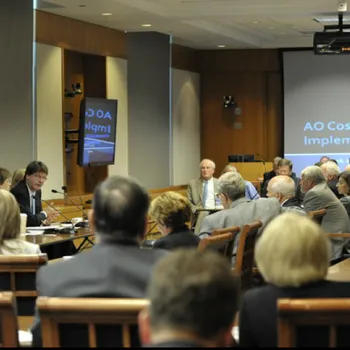This situation is likely to last for the foreseeable future, making it essential that the Judiciary continue its cost-containment strategy begun in 2004 and adapted over time. The Judicial Conference emphasized effective and efficient use of public resources as a key operating principle in the Strategic Plan for the Federal Judiciary, which it approved in September 2010 and began implementing throughout fiscal year 2011.
At a cost-containment summit held in Washington, DC, in September 2011, Judicial Conference committee chairs discussed all aspects of Judiciary spending. Their goal was to reduce expenses and plan for a constrained budget climate if, as anticipated, court appropriations were severely reduced.
Judicial Conference committee chairs agreed to pursue a prioritized list of cost-containment initiatives. Some proposals were considered for implementation in FY 2012 and for FY 2013 financial plans. For example, the Judicial Resources Committee has accelerated reviews of the work measurement formulas. Other suggestions are longer-term and may require Judicial Conference approval.
Early in 2011, Executive Committee Chair Chief Judge David B. Sentelle sent a list of potential cost-cutting "quick hits" for immediate review by the chairs of all Judicial Conference committees. Judges and court managers on Judiciary advisory committees helped develop the cost-cutting recommendations. These ideas laid the foundation for the cost-containment summit.
The initiatives produced by the cost-containment summit were provided to the appropriate Judicial Conference committees, with encouragement to develop additional ideas. Committee recommendations were reviewed by the Judicial Conference Budget Committee in January 2011, and by the Executive Committee at its February meeting. At its March 2012 meeting, the Judicial Conference is expected to consider a comprehensive cost-containment strategy for the Judiciary.
Many cost-containment initiatives are already in progress:
- In FY 2011, the Court Administration and Case Management Committee examined the role of libraries and various cost-saving options. As a result, two satellite libraries were closed, other closings are under consideration, and library and chambers collections have been reduced.
- For the first time in FY 2011, courts implemented a new pay policy for employees in the Court Personnel System. The policy limits the number of pay increases, while providing unit executives flexibility to grant discretionary increases based on individual employee work contributions.
- Changes to the Judiciary's schedules to dispose of paper case file records, while preserving historical files, will lower Judiciary costs by approximately $3 million per year. (See "Records Management" for details.)
- A simple formatting change in the Judiciary's electronic bankruptcy noticing program is expected to create substantial savings in noticing and postage costs.
- Courthouse construction costs have been reduced through revisions to the U.S. Courts Design Guide, by imposing circuit rent budget controls and adopting courtroom sharing policies for senior, magistrate, and bankruptcy judges.
At the Administrative Office, the Director formed an AO cost-containment task force in January 2011 representing all parts of the agency, with the mission of developing short- and long-term recommendations for meeting core AO responsibilities with substantially reduced resources. This entailed a review of the policy and process alternatives available, and developing specific actions for containing costs in fiscal years 2012, 2013, and beyond. The task force completed its work in April, focusing on funds supporting the operation of the AO as well as funds managed centrally that support court operations. AO executive management endorsed the recommendations in May and many recommendations have been implemented for 2011 and 2012.

